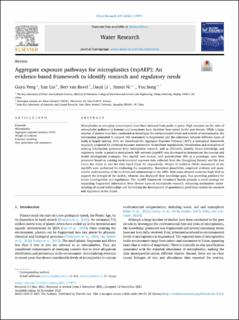| dc.contributor.author | Peng, Guyu | |
| dc.contributor.author | Lin, Yan | |
| dc.contributor.author | van Bavel, Bert | |
| dc.contributor.author | Li, Daoji | |
| dc.contributor.author | Ni, Jinren | |
| dc.contributor.author | Song, You | |
| dc.date.accessioned | 2022-03-11T07:51:38Z | |
| dc.date.available | 2022-03-11T07:51:38Z | |
| dc.date.created | 2021-11-19T10:09:59Z | |
| dc.date.issued | 2022 | |
| dc.identifier.citation | Water Research. 2022, 209, 117873. | en_US |
| dc.identifier.issn | 0043-1354 | |
| dc.identifier.uri | https://hdl.handle.net/11250/2984447 | |
| dc.description.abstract | Microplastics as emerging contaminants have been detected from peaks to poles. High concerns on the risks of microplastic pollution to humans and ecosystems have therefore been raised in the past decade. While a large number of studies have been conducted to investigate the environmental levels and toxicity of microplastics, the information generated to support risk assessment is fragmented and the coherence between different types of study is largely lacking. Here we introduced the Aggregate Exposure Pathway (AEP), a conceptual framework originally proposed for chemical exposure assessment, to facilitate organization, visualization and evaluation of existing information generated from microplastic research, and to efficiently identify future knowledge and regulatory needs. A putative microplastic AEP network (mpAEP) was developed to demonstrate the concept and model development strategies. Two mpAEP case studies, with polyethylene (PE) as a prototype, were then presented based on existing environmental exposure data collected from the Changjiang Estuary and the East China Sea (Case I), and the Oslo Fjord (Case II), respectively. Weight of evidence (WoE) assessment of the mpAEPs were performed for evaluating the essentiality, theoretical plausibility, empirical evidence and quantitative understanding of the evidence and relationships in the AEPs. Both cases showed moderate/high WoE to support the strength of the models, whereas also displayed clear knowledge gaps, thus providing guidance for future investigations and regulations. The mpAEP framework introduced herein presents a novel strategy for organizing fragmented information from diverse types of microplastic research, enhancing mechanistic understanding of causal relationships and facilitating the development of quantitative prediction models for research and regulation in the future. | en_US |
| dc.language.iso | eng | en_US |
| dc.publisher | Elsevier | en_US |
| dc.rights | Navngivelse 4.0 Internasjonal | * |
| dc.rights.uri | http://creativecommons.org/licenses/by/4.0/deed.no | * |
| dc.title | Aggregate exposure pathways for microplastics (mpAEP): An evidence-based framework to identify research and regulatory needs | en_US |
| dc.type | Peer reviewed | en_US |
| dc.type | Journal article | en_US |
| dc.description.version | publishedVersion | en_US |
| dc.rights.holder | © 2021 The Authors | en_US |
| dc.source.pagenumber | 10 | en_US |
| dc.source.volume | 209 | en_US |
| dc.source.journal | Water Research | en_US |
| dc.identifier.doi | 10.1016/j.watres.2021.117873 | |
| dc.identifier.cristin | 1956273 | |
| dc.relation.project | Norges forskningsråd: 160016 | en_US |
| dc.source.articlenumber | 117873 | en_US |
| cristin.ispublished | true | |
| cristin.fulltext | original | |
| cristin.qualitycode | 2 | |

